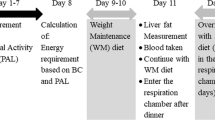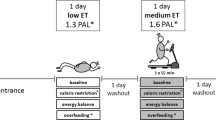Abstract
OBJECTIVE: This study investigated how energy expenditure may contribute to energy balance in lean male individuals consuming a diet either high or low in fat.
METHODS: Fifteen high-fat phenotypes (HF) and 15 low-fat phenotypes (LF) participated in the study. Energy intake and macronutrient intake variables were assessed using a food frequency questionnaire and 3 day food diaries. Total energy expenditure (TEE) was estimated from 24 h heart rate monitoring and factorial methods. Habitual physical activity was measured using the Baecke questionnaire.
RESULTS: There were no anthropometric differences between HF and LF. HF had a significantly higher heart rate over 24 h; this was particularly evident during the sleeping phase. There were no differences in TEE between HF and LF, but HF were more sedentary than LF.
CONCLUSIONS: In these young male subjects a high fat intake was associated with increased sedentariness; however, higher heart rates (basal and post-meal) could indicate that energy balance was achieved by relatively high basal metabolism and an increase in dietary-induced themogenesis (physiological route). In contrast LF could maintain energy balance through relatively high levels of physical activity (behavioural route).
This is a preview of subscription content, access via your institution
Access options
Subscribe to this journal
Receive 12 print issues and online access
$259.00 per year
only $21.58 per issue
Buy this article
- Purchase on Springer Link
- Instant access to full article PDF
Prices may be subject to local taxes which are calculated during checkout

Similar content being viewed by others
References
Blundell JE, Cotton JR, Delargy H, Green S, Greenough A, King NA, Lawton CL . The fat paradox: fat-induced satiety signals versus high fat overconsumption Int J Obes Relat Metab Disord 1995 19: 832–835.
Lawton CL, Burley VJ, Wales JK, Blundell JE . Dietary fat and appetite control in obese subjects: weak effects on satiation and satiety Int J Obes Relat Metab Disord 1993 17: 409–416.
Prentice AM, Jebb SA . Obesity in Britain: gluttony or sloth? BMJ 1995 311: 437–439.
Willett WC . Is dietary fat a major determinant of body fat? Am J Clin Nutr 1998 673 (Suppl): 556S–562S.
Seidell JC . Dietary fat and obesity: an epidemiologicalperspective Am J Clin Nutr 1998 673 (Suppl): 546S–550S.
Macdiarmid JI, Blundell JE . Dietary under-reporting: what people say about recording their food intake Eur J Clin Nutr 1997 51: 199–200.
Lissner L, Heitmann BL . Dietary fat and obesity: evidence from epidemiology Eur J Clin Nutr 1995 49: 79–90.
Goris AH, Westerterp KR . Underreporting of habitual food intake is explained by undereating in highly motivated lean women J Nutr 1999 129: 878–882.
Blundell JE, Cooling J . High-fat and low-fat (behavioural) phenotypes: biology or environment? Proc Nutr Soc 1999 58: 1–5.
Golay A, Bobbioni E . The role of dietary fat in obesity Int J Obes Relat Metab Disord 1997 21 (Suppl 3): S2–S11.
Blundell JE, Macdiarmid JI . Passive overconsumption. Fat intake and short-term energy balance Ann NY Acad Sci 1997 827: 392–407.
Cooling J, Blundell JE . Are high-fat and low-fat consumers distinct phenotypes? Differences in the subjective and behavioural response to energy and nutrient challenges Eur J Clin Nutr 1998 52: 193–201.
Cooling J, Blundell JE . Differences in energy expenditure and substrate oxidation between habitual high fat and low fat consumers (phenotypes) Int J Obes Relat Metab Disord 1998 22: 612–618.
Cooling J, Barth J, Blundell JE . The high-fat phenotype: is leptin involved in the adaptive response to a high fat (high energy) diet? Int J Obes Relat Metab Disord 1998 22: 1132–1135.
Goldberg GR . From individual variation in energy intakes… to variations in energy requirements and adaptations to them Br J Nutr 1997 78 (Suppl 2): S81–94.
Livingstone EBE, Coward WA, Prentice PA, Davies PSW, Strain JJ, McKenna PG, Mahoney CA, White JA, Stewart CM, Kerr JJ . Daily energy expenditure in free-living children: comparison of heart-rate monitoring with the doubly labelled water (2H218O) method Am J Clin Nutr 1992 56: 343–352.
Fleury C, Neverova M, Collins S, Raimbault S, Champigny O, Levi-Meyrueis C, Boulillaud F, Seldin MF, Surwit RS, Riquier D, Warden CH . Uncoupling protein-2: a novel gene linked to obesity and hyperinsulinemia Nature Genet 1997 15: 269–272.
Margetts BM, Cade JE, Osmond C . Comparison of a food frequency questionnaire with a diet record Int J Epidemiol 1989 18: 868–873.
Bouchard C, Tremblay A, Leblanc C, Lortie G, Savard R, Theriault G . A method to assess energy expenditure in children and adults Am J Clin Nutr 1983 37: 461–467.
Baecke JAHJ, Burema J, Frijters JER . A short questionnaire for the measurement of habitual physical activity in epidemiological studies Am J Clin Nutr 1982 36: 936–942.
Spurr GB, Prentice AM, Murgatroyd PR, Goldberg GR, Reina JC, Christman NT . Energy expenditure from minute-by-minute heart rate recording: comparison with indirect calorimetry Am J Clin Nutr 1988 48: 552–559.
Cooling J, Blundell JE . High-fat and low-fat phenotypes: methodological issues concerning energy intake and expenditure Int J Obes Relat Metab Disord 1999 23 (Suppl 5): S91.
Macdiarmid JI, Cade JE, Blundell JE . High and low fat consumers, their macronutrient intake and body mass index: further analysis of the national diet and nutrition survey of British adults Eur J Clin Nutr 1996 50: 505–512.
Health of the nation. A strategy for health in England. HMSO: London 1992.
Melanson KJ, Saltzman E, Russell RR, Roberts SB . Fat oxidation in response to four graded energy challenges in younger and older women Am J Clin Nutr 1997 66: 860–866.
Reed DR, Tordoff MG, Friedman MI . Enhanced acceptance and metabolism of fats by rats fed a high-fat diet Am J Physiol 1991 261 (5 Pt 2): R1084–1088.
French SJ, Murray B, Rumsay RDE, Fadzlin R, Read NW . Adaptation to high-fat diets: effects on eating behaviour and plasma CCK Br J Nutr 1995 73: 179–189.
Bouchard C . Can obesity be prevented? Nutr Rev 1996 54: S125–S130.
Zurlo F, Lillioja S, Esposito-Del Puente A, Nyomba BL, Raz I, Saad MF, Swinburn BA, Knowler WC, Bogardus C, Ravussin E . Low ratio of fat to carbohydrate oxidation as predictor of weight gain: study of 24-h RQ Am J Physiol 1990 259: E650–E657.
Schrauwen P, van Marken Lichtenbelt WD, Saris WHM, Westerterp KR . Changes in fat oxidation in response to a high-fat diet Am J Clin Nutr 1997 66: 276–282.
Racette SB, Schoeller DA, Kushner RF . Comparison of heart rate and physical activity recall with doubly labelled water in obese women Med Sci Sports Exercise 1995 27: 126–133.
McCrory MA, Mole PA, Nommsen-Rivers LA, Dewey KG . Between-day and within-day variability in the relation between heart rate and oxygen consumption: effect on the estimation of energy expenditure by heart rate monitoring Am J Clin Nutr 1997 66: 18–25.
Morio B, Ritz P, Verdier E, Montaurier C, Beaufrere B Vermorel M . Critical evaluation of the factorial and heart-rate recording methods for the determination of energy expenditure of free-living elderly people Br J Nutr 1997 78: 709–722.
Author information
Authors and Affiliations
Corresponding author
Rights and permissions
About this article
Cite this article
Cooling, J., Blundell, J. Lean male high- and low-fat phenotypes—different routes for achieving energy balance. Int J Obes 24, 1561–1566 (2000). https://doi.org/10.1038/sj.ijo.0801499
Received:
Revised:
Accepted:
Published:
Issue Date:
DOI: https://doi.org/10.1038/sj.ijo.0801499
Keywords
This article is cited by
-
Stress Response and Appetite Regulation in Overweight and Normal-Weight Young Men: Preliminary Data
Psychological Studies (2019)
-
Obesity: Outwitting the wisdom of the body?
Current Neurology and Neuroscience Reports (2005)



